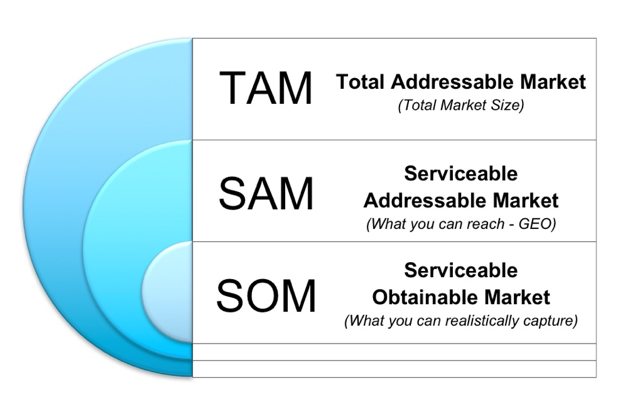 The most successful companies have a strategic plan that includes a clear view of which markets they will serve and why. This may sound simple on the surface, but how your organization selects which markets to pursue has tremendous implications for managing and growing your business. Get it right and you can:
The most successful companies have a strategic plan that includes a clear view of which markets they will serve and why. This may sound simple on the surface, but how your organization selects which markets to pursue has tremendous implications for managing and growing your business. Get it right and you can:
- Create equitable and more profitable sales territories;
- Align the efforts of your sales and marketing teams on the right accounts;
- Staff your business appropriately and invest in effective tools for growth; and
- Persuade investors to fund you.
Get it wrong and you risk being perpetually under or overstaffed, entering markets that don’t make sense, wasting sales and marketing resources on the wrong opportunities and, of course, not meeting your numbers. You also risk disappointing your investors, who will limit or eliminate any additional funding you may need to effectively grow your business.
Why Traditional Market Reports Are Not Enough
For years, companies have used traditional reports from analyst firms to estimate the size of their markets and inform their decisions on which markets to pursue. Typically, these reports are based on company surveys conducted and interpreted by analysts and provide quick, high-level numbers of the potential size and growth of a market.

These reports can also give you the market size for your particular product category per country. While this type of data may provide a starting point for your planning efforts, it doesn’t really give you the in-depth information you need to understand why you should enter a particular market. The degree of subjectivity in these reports also makes it difficult to base your revenue projections on the numbers. In addition, none of the data in these reports is actionable for your sales and marketing teams.
Technology Intelligence Instills Confidence In Planning
When companies ask us for tech intelligence to help them develop better plans, what they’re really looking to do is instill confidence in the planning process by making it less subjective, more accurate and easily actionable. To do this, they need much deeper insights than what’s provided on an analyst report, which is generally an estimate of your total available market (TAM) or serviceable available market (SAM).
Fine-tuning your business plan and making realistic revenue projections requires more than just a TAM or a SAM. It involves a thorough understanding of your serviceable obtainable market (SOM), which represents the segment of the market you feel you could capture with your solution. And to get your SOM, you need detailed tech intelligence on what products your accounts or prospective buyers have installed.

To highlight this fact, consider how you would make the decision between investing sales and marketing resources in France or Germany if you only had the following data points on market size provided in a typical analyst report:
Market Size
- France — $15 billion
- Germany — $45 billion
On the surface, it would seem that the market in Germany was three times as big as France and so that would be the place to invest. However, what if the majority of the German market was being served by competitors your solution does not compete well against, while the French market had very little competition? Without tech intelligence showing you where your competitors are installed, you’d have no way of knowing this and might jump into a market saturated by competition you have very little likelihood of displacing. Your revenue projections would certainly be impacted and you would be at risk of misappropriating resources by going after the wrong opportunity.
Alternatively, what if you were looking at different regions or countries and wanted to identify which situations represented the best growth opportunities for your business. Again, knowing the estimated market size isn’t going to help you much. But what if you knew what companies had budgeted to spend on your category of product by region? You could then compare these budgets to what companies are already spending with you to determine how much more of their business you could realistically capture — what companies call share of wallet.
These are just a few examples of how deeper-level tech intelligence can enable your organization to plan more effectively and make better business decisions. In addition to these examples:
- Sales leaders use granular tech intelligence to map out and divide their sales territories into regions that contain accounts that match their ideal customer profile (ICP). Critical components of their ICP include knowing what technology products accounts in a particular region have installed and what they spend on those technologies;
- Sales and marketing teams use tech intelligence to develop and deliver highly relevant campaigns with messaging customized to a prospect’s strategic initiatives, existing solutions and pain points; and
- Product teams use tech trending information to make decisions on which products they need to enhance or end, and what new solutions they need to develop to better compete in the future.
Many companies today will continue to rely on market research reports to guide their planning. Astute companies supplement this information with detailed tech intelligence to help validate or dig deeper into the high-level market-size numbers. They know that tech intelligence de-risks market entry decisions, assures resources are well-targeted and is a critical component to accurate revenue projections.
Detailed technology intelligence will be a game-changer for tech companies in 2020 and beyond. It will ensure they target the right markets, find the best opportunities for expansion and increase their chances of meeting or exceeding their numbers when the year-end moment of truth comes around again.
Elizabeth Cholawsky is the CEO of HG Insights. She is a seasoned/established executive leader in the technology industry with a strong focus on growing successful SaaS-based businesses. Elizabeth has led and worked with companies to build market-leading offerings, using in-house talent as well as through partnerships and acquisitions. Prior to joining HG Insights, she was CEO of Support.com (NASDAQ: SPRT), where she transformed the business from being solely reliant on outsourced services revenue to selling a SaaS product that intelligently ran large contact centers.







